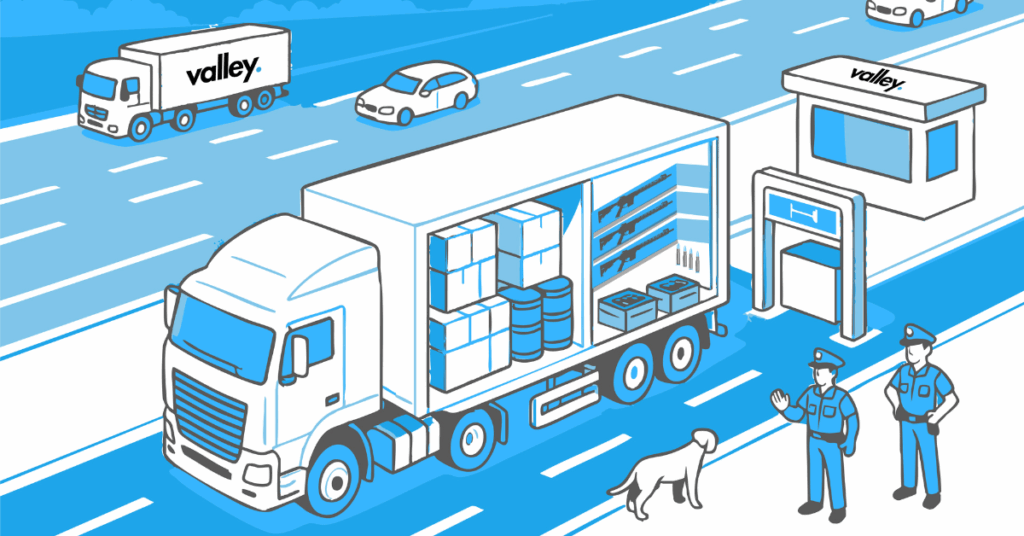Trucking Arms Smuggling: Hidden Risks on Commercial Routes

Trucking arms smuggling is a growing global problem. The trucking sector is vital to economies, moving fuel, food, and medicine every day. But traffickers exploit these same routes to move illicit weapons. Semi-automatic rifles, handguns, and even military-style gear are hidden among regular freight. This article explains why trucks are targeted, real-world cases, the risks for businesses, and steps companies can take to protect themselves.
Quick Answer
Traffickers use trucks for arms smuggling because they offer cover, reach, and cargo capacity. Weapons are concealed in shipments of produce, auto parts, or industrial goods. Fleets can reduce exposure by screening contracts, training staff, investing in tracking technology, and working with enforcement partners.
Why Traffickers Use Trucks for Weapons
Criminal networks prefer trucks for these reasons:
- Capacity and concealment: A single truck can hide thousands of pounds of cargo under legitimate goods.
- Reputable cover: Millions of shipments move weekly and traffickers hide guns in plain sight with normal cargo.
- Broad access: Trucks cross borders, ports, and highways, reaching both cities and rural areas.
- Subcontracting flaws: Smaller carriers with less oversight leave openings for illicit loads.
Mexico Case: Cartel Shipments
In 2020, Mexican authorities stopped a truck in Tamaulipas near the U.S. border. They found semi-automatic rifles, grenades, and ammunition concealed beneath flour bags. The shipment was tied to a cartel supplying local gangs. Even if drivers were unaware, the trucking company faced legal and reputational damage.
U.S. to Canada Case
At the Ambassador Bridge in 2022, Canadian border officers intercepted a tractor-trailer marked as auto parts. Inside, they found more than 200 illegal firearms, including semi-automatic rifles and handguns. Investigators linked it to an organized smuggling ring. This shows trafficking crosses borders, using legitimate-looking carriers. Similar cases have been prosecuted in U.S. courts, such as when three Canadian citizens were charged with smuggling firearms across the border (U.S. Department of Justice).
How Arms Smuggling Hides in Trucking
Common tactics include:
False shipping documents: Fake invoices describe boxes of guns as machine parts.
Mixed cargo: Weapons are hidden among produce, furniture, or industrial goods.
Modified compartments: Some trailers are altered to create hidden sections.
Compromised workers: Drivers, brokers, or warehouse staff may be bribed or threatened.
The Global Impact of Arms Trafficking
The United Nations Office on Drugs and Crime (UNODC) estimates that the global illegal arms trade is worth billions each year (UNODC Global Firearms Study). Weapons moved by trucks often fuel:
- Street gangs and cartels, Increasing violent crime.
- Conflict zones, Feeding wars and instability.
- Terrorist groups, Expanding threats to global security.
The Consequences for Trucking Companies
When a truck is caught smuggling weapons, companies may face:
- Asset seizure, Trucks, trailers, and cargo confiscated.
- Legal exposure, Owners and drivers charged if negligence is proven.
- Contract loss, Shippers and brokers cut ties with suspect carriers.
- Reputation damage, A lasting hit to credibility and trust.
Lessons from Enforcement Cases
Enforcement agencies worldwide target arms smuggling by truck. Examples include:
- Spain 2021, Police seized 1,600 firearms hidden in industrial machinery, tied to a European gang.
- U.S. 2019, Border officials uncovered firearm parts hidden in auto parts crates.
These cases show traffickers adapt constantly. Many loads are only caught through intelligence, tips, or scanning technology.
What the Industry Can Do
Steps to lower exposure include:
Stronger oversight: Review contracts, avoid vague cargo descriptions, and work with long-term partners.
Tech investment: GPS tracking, electronic seals, and tamper checks.
Driver training: Teach staff to spot tampering and report suspicious loads.
Cooperation: Keep open communication with enforcement, report unusual offers or cargo.
FAQs on Trucking Arms Smuggling
What is trucking arms smuggling?
- It is the use of freight trucks to move illegal weapons hidden in normal loads.
Why do traffickers prefer trucks?
- They offer cover, reach, and capacity to hide weapons across borders and regions.
What weapons are usually smuggled?
- Semi-automatic rifles, handguns, grenades, and firearm parts.
Can companies be liable if unaware?
- Yes, failure to vet contracts or subcontractors can be seen as negligence.
How can fleets protect themselves?
- By screening loads, training staff, and using tracking tools to ensure supply chain security.
Final Thoughts
Trucking arms smuggling is a hidden but serious risk. Criminals use trucks for cover, but fleets can defend themselves. With stronger vetting, driver training, and closer cooperation with enforcement, companies reduce exposure and protect communities. Every careful step makes a difference.
